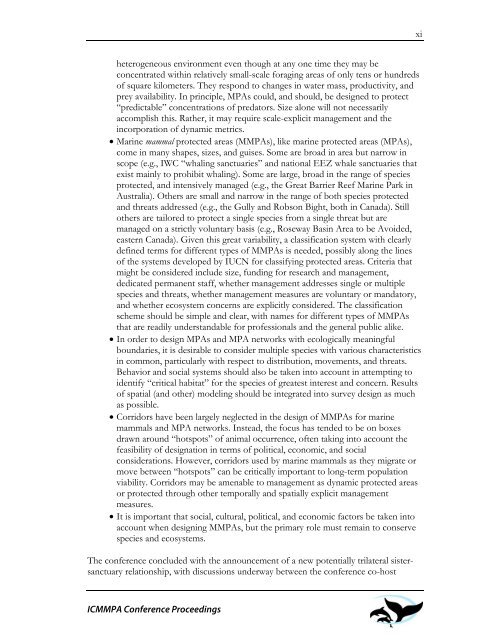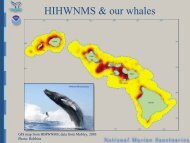The First International Conference on Marine Mammal Protected Areas
The First International Conference on Marine Mammal Protected Areas
The First International Conference on Marine Mammal Protected Areas
Create successful ePaper yourself
Turn your PDF publications into a flip-book with our unique Google optimized e-Paper software.
heterogeneous envir<strong>on</strong>ment even though at any <strong>on</strong>e time they may be<br />
c<strong>on</strong>centrated within relatively small-scale foraging areas of <strong>on</strong>ly tens or hundreds<br />
of square kilometers. <str<strong>on</strong>g>The</str<strong>on</strong>g>y resp<strong>on</strong>d to changes in water mass, productivity, and<br />
prey availability. In principle, MPAs could, and should, be designed to protect<br />
“predictable” c<strong>on</strong>centrati<strong>on</strong>s of predators. Size al<strong>on</strong>e will not necessarily<br />
accomplish this. Rather, it may require scale-explicit management and the<br />
incorporati<strong>on</strong> of dynamic metrics.<br />
• <strong>Marine</strong> mammal protected areas (MMPAs), like marine protected areas (MPAs),<br />
come in many shapes, sizes, and guises. Some are broad in area but narrow in<br />
scope (e.g., IWC “whaling sanctuaries” and nati<strong>on</strong>al EEZ whale sanctuaries that<br />
exist mainly to prohibit whaling). Some are large, broad in the range of species<br />
protected, and intensively managed (e.g., the Great Barrier Reef <strong>Marine</strong> Park in<br />
Australia). Others are small and narrow in the range of both species protected<br />
and threats addressed (e.g., the Gully and Robs<strong>on</strong> Bight, both in Canada). Still<br />
others are tailored to protect a single species from a single threat but are<br />
managed <strong>on</strong> a strictly voluntary basis (e.g., Roseway Basin Area to be Avoided,<br />
eastern Canada). Given this great variability, a classificati<strong>on</strong> system with clearly<br />
defined terms for different types of MMPAs is needed, possibly al<strong>on</strong>g the lines<br />
of the systems developed by IUCN for classifying protected areas. Criteria that<br />
might be c<strong>on</strong>sidered include size, funding for research and management,<br />
dedicated permanent staff, whether management addresses single or multiple<br />
species and threats, whether management measures are voluntary or mandatory,<br />
and whether ecosystem c<strong>on</strong>cerns are explicitly c<strong>on</strong>sidered. <str<strong>on</strong>g>The</str<strong>on</strong>g> classificati<strong>on</strong><br />
scheme should be simple and clear, with names for different types of MMPAs<br />
that are readily understandable for professi<strong>on</strong>als and the general public alike.<br />
• In order to design MPAs and MPA networks with ecologically meaningful<br />
boundaries, it is desirable to c<strong>on</strong>sider multiple species with various characteristics<br />
in comm<strong>on</strong>, particularly with respect to distributi<strong>on</strong>, movements, and threats.<br />
Behavior and social systems should also be taken into account in attempting to<br />
identify “critical habitat” for the species of greatest interest and c<strong>on</strong>cern. Results<br />
of spatial (and other) modeling should be integrated into survey design as much<br />
as possible.<br />
• Corridors have been largely neglected in the design of MMPAs for marine<br />
mammals and MPA networks. Instead, the focus has tended to be <strong>on</strong> boxes<br />
drawn around “hotspots” of animal occurrence, often taking into account the<br />
feasibility of designati<strong>on</strong> in terms of political, ec<strong>on</strong>omic, and social<br />
c<strong>on</strong>siderati<strong>on</strong>s. However, corridors used by marine mammals as they migrate or<br />
move between “hotspots” can be critically important to l<strong>on</strong>g-term populati<strong>on</strong><br />
viability. Corridors may be amenable to management as dynamic protected areas<br />
or protected through other temporally and spatially explicit management<br />
measures.<br />
• It is important that social, cultural, political, and ec<strong>on</strong>omic factors be taken into<br />
account when designing MMPAs, but the primary role must remain to c<strong>on</strong>serve<br />
species and ecosystems.<br />
<str<strong>on</strong>g>The</str<strong>on</strong>g> c<strong>on</strong>ference c<strong>on</strong>cluded with the announcement of a new potentially trilateral sistersanctuary<br />
relati<strong>on</strong>ship, with discussi<strong>on</strong>s underway between the c<strong>on</strong>ference co-host<br />
ICMMPA <str<strong>on</strong>g>C<strong>on</strong>ference</str<strong>on</strong>g> Proceedings<br />
xi



